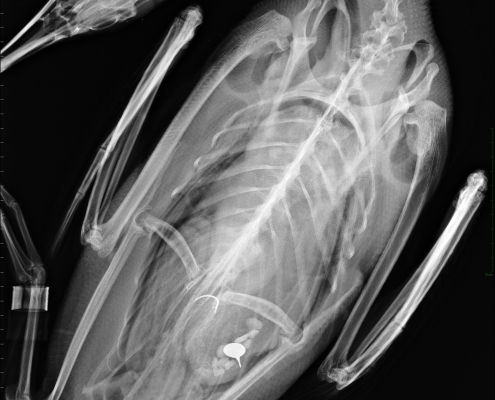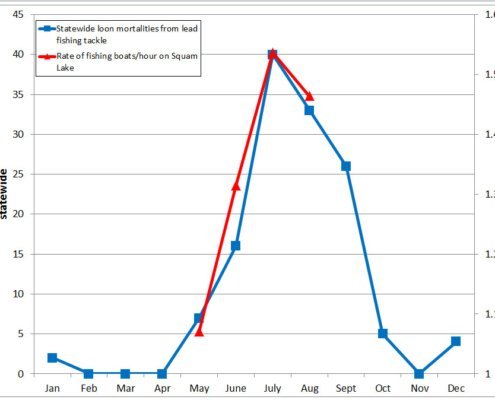Tackle Laws in New Hampshire
LPC’s data regarding the effect of ingested lead fishing tackle on New Hampshire’s loon population resulted in first-in-the-nation legislation to restrict the use of small lead sinkers and jigs on lakes and ponds within New Hampshire in 2000. In 2005 and 2006, New Hampshire extended this legislation to first ban the use of this tackle on all freshwaters in New Hampshire and then ban the sale of this same tackle. The most recent legislation, which restricts the sale and freshwater use of all lead sinkers and lead-headed jigs weighing one ounce or less, was passed in 2013. This bill went into effect June 1, 2016 and once again made New Hampshire a leader in safeguarding loons from this avoidable cause of mortality.
Lead fishing tackle is the single largest cause of documented loon mortalities in New Hampshire.
Lead Tackle Buyback
Bans on the sale of lead fishing tackle play an integral role in protecting loons because they help to prevent new lead tackle from entering the system. Since the lead tackle known to kill loons can no longer be sold or purchased in New Hampshire, the next step to protect loons is to remove illegal lead tackle from active use. In 2018, LPC partnered with New Hampshire Fish and Game to conduct a first-in-the-nation lead tackle buyback program. The program provides a financial incentive to encourage anglers to make the switch to non-lead fishing tackle. Buyback participants exchange 1 ounce or more of illegal lead tackle at participating locations for a $10 store voucher. These vouchers can then be used to purchase loon-safe tackle or other supplies. All Lead Tackle Buyback participants also have the chance to win additional prizes—the person who turns in the most illegal lead tackle at each participating retailer wins a $100 prize, while the person who turns in the second-highest amount wins a $50 prize. Since 2018, we have collected over 50,000 lead sinkers and jigs weighing one ounce or less. Had they remained in circulation, any one of these pieces of tackle could have killed a loon.
How do loons ingest lead?
The yearly peak of loon deaths from ingested tackle coincide with the peak of fishing activity on NH’s lakes. This and other evidence indicates that loons primarily ingest fishing tackle from active use. Loons can swallow lead sinkers or jigs attached to a fish that has broken an angler’s line or may strike directly at a piece of tackle on an angler’s line as it is trolled or retrieved. Loons may also swallow lead tackle from the lake bottom along with the pebbles they ingest to help grind up and digest food; however, LPC’s data suggests that this is less common. The ingestion of lead fishing tackle is virtually always fatal for loons, with death typically occurring within 2–4 weeks.
In this video, LPC biologist Tiffany Grade explains how lead poisoning from lead tackle ingestion has affected New Hampshire’s loons.
Frequently Asked Questions
How do loons ingest lead fishing tackle?
The majority of loons that die from ingested lead tackle acquire it as a result of current fishing activity. They may 1) strike at bait as it is being retrieved through the water; 2) strike at a fish that is being reeled in by an angler; or 3) ingest a fish that has broken a line and has ingested or attached tackle.
In some cases, loons may also pick up small pieces of lead tackle from the lake bottom. Loons normally ingest small pebbles as grit, and they may mistake a split shot or other piece of tackle for a small pebble.
How does lead tackle kill loons?
Once ingested, the lead tackle goes into the loon’s gizzard. The acid and grinding action of the gizzard erodes the lead, which then passes into the bloodstream and organs and poisons the loon. Even a single small lead split shot sinker is fatal to loons, which will die within 2-4 weeks of ingesting a piece of lead fishing tackle.
While some might assume that ingestion of fish hooks might cause loons to die, in fact only a small number of loons die from injuries resulting from swallowing hooks. Loons have evolved to swallow spiny fish so they are able to deal with fish hooks. In the vast majority of loons, the hooks (either hooks on jigs or separate hooks) are very rapidly broken down in the gizzard.
Once a loon has ingested lead tackle, can it be saved?
Only a few loons have been successfully treated for lead poisoning and released. Usually, loons do not display symptoms until lead is already at toxic levels in their bloodstream. At that point, the only option is to humanely euthanize the loon.
What types and sizes of lead tackle do loons ingest? Do weedguards, etc. make a difference?
Loons ingest both lead fishing sinkers and jigs. A sinker is attached to a fishing line to sink it, while a jig is a hook with a lead weight molded around it. Loons have ingested jigs weighing more than 4 oz and sinkers weighing more than 2.5 oz.
The acid and grinding action of a loon’s gizzard erodes lead sinkers and jigs, so hooks, weed guards, and other components of this tackle may no longer be present when it is removed from dead loons. Loons’ ingestion of lead jigs with and without attachments like weedguards has been documented, and neither these nor a painted coating will protect loons from lead poisoning.
How do loons ingest large jigs if their normal food is small fish?
Although loons often eat 4-8” fish, they may occasionally eat fish as large as 12” or more, and they have even been documented eating fish as large as 16-17”. If these large fish have ingested tackle and are trailing a broken line, they are not able to swim as well as unimpaired fish and are easy prey for loons. The loons then ingest the tackle—which may be a large jig—as well as the fish. Loons may also strike at large fish or tackle as they are being reeled in.
Why are loons so susceptible to threats affecting adult survival?
Loons are a long-lived species (20-30 years), do not breed until their sixth or seventh year of life on average, and then only produce an average of one chick per pair every two years. Loons need many opportunities to breed over the course of their long life to produce enough surviving chicks to contribute to the population, so survival of adult loons is the most important factor in assuring the continued viability of our state’s loon population.
Does mortality from lead fishing tackle affect New Hampshire’s loons at a population level?
Yes. Lead tackle mortality has inhibited the recovery of New Hampshire’s loon population and reduced the state’s overall number of loons. Using mortality data from 1989-2012, LPC estimated that mortality from lead fishing tackle resulted in a 43% reduction in the state’s loon population. In other words, instead of the 638 adult loons LPC counted in the state in 2012, New Hampshire would have had an estimated 911 adult loons without mortality from lead tackle. LPC recently published this study in the peer-reviewed Journal of Wildlife Management. Click here to read the paper.




